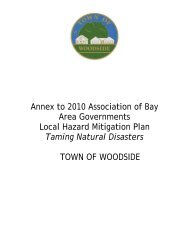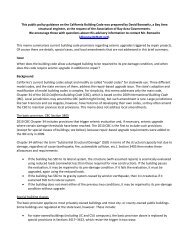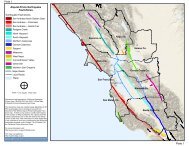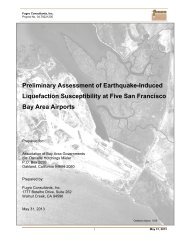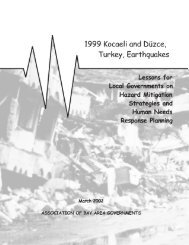Safe Enough to Stay - ABAG Earthquake and Hazards Program
Safe Enough to Stay - ABAG Earthquake and Hazards Program
Safe Enough to Stay - ABAG Earthquake and Hazards Program
- No tags were found...
Create successful ePaper yourself
Turn your PDF publications into a flip-book with our unique Google optimized e-Paper software.
<strong>Safe</strong> <strong>Enough</strong> <strong>to</strong> <strong>Stay</strong>Assessing the expectedperformance of individualbuildings before theearthquakeWhile shelter-in-place capacity is needed after the earthquake, theability <strong>to</strong> assess an individual building’s expected performance mustbe done beforeh<strong>and</strong>. What engineering criteria should be used, prior<strong>to</strong> the event, <strong>to</strong> determine whether a house, apartment building,condominium or other housing facility has shelter-in-place capacityadequate for a magnitude 7.2 San Andreas earthquake?We recommend that feasible shelter-in-place evaluation criteriashould be based on existing st<strong>and</strong>ards already familiar <strong>to</strong> practicingengineers <strong>and</strong> code officials. Those st<strong>and</strong>ards should take in<strong>to</strong>account:• Cost-effective procedures (as opposed <strong>to</strong> relying on complicatedanalysis)• The range of residential structure types in San Francisco• Differences between new <strong>and</strong> existing structures (unlike mostbuilding code provisions)• Nonstructural conditions that affect shelter-in-place habitabilityThis report recommends the use of the national st<strong>and</strong>ard called“Seismic Evaluation of Existing Buildings,” 35 also known as ASCE 31.To determine whether a building has shelter-in-place capacity, theASCE 31 criteria should be modified <strong>to</strong> consider only the types ofdamage that could be critical obstacles for sheltering in place. Thecriteria should reference approved maps of relevant hazards <strong>and</strong>expected infrastructure performance.What Is ACSE 31?In this report, we refer <strong>to</strong> ASCE 31, a national st<strong>and</strong>ard for theseismic evaluation of existing buildings that was developed bythe American Society of Civil Engineers. ASCE 31’s main featureis a set of checklists that guide the engineer <strong>to</strong> look for criticaldeficiencies in a building’s structure, architecture <strong>and</strong> systems,based on observed damage patterns from past earthquakes. Withthese checklists, supplemented by engineering calculations, abuilding can be evaluated with respect <strong>to</strong> how we can expect it <strong>to</strong>perform in a future expected earthquake: whether it will likely besafe <strong>and</strong> occupiable (Immediate Occupancy); safe <strong>and</strong> repairable(Life <strong>Safe</strong>ty); or not safe due <strong>to</strong> possible collapse, falling hazards, fireor hazardous materials release. Because ASCE 31 does not directlyaddress the question of shelter in place as we define it here, we areproposing ways <strong>to</strong> adapt it <strong>to</strong> this new thinking about earthquakeresilience.This approach — i.e., modifying a national st<strong>and</strong>ard <strong>to</strong> make itapplicable <strong>to</strong> certain performance objectives — has precedent.California’s Office of Statewide Health Planning <strong>and</strong> Development(OSHPD) <strong>and</strong> Division of the State Architect (DSA) have used thisstrategy for the m<strong>and</strong>a<strong>to</strong>ry evaluation <strong>and</strong> retrofit of hospitals <strong>and</strong> forvoluntary evaluation of K-12 schools, respectively. To implement thisapproach, SPUR’s performance objectives — both the magnitude 7.2scenario earthquake <strong>and</strong> the shelter-in-place st<strong>and</strong>ard — must betranslated in<strong>to</strong> terms used within ASCE 31, particularly “hazard level”<strong>and</strong> “performance level”:Hazard levelWe have based our shelter-in-place objective on the scenario of amagnitude 7.2 earthquake on the peninsula segment of the SanAndreas Fault. While a scenario event is useful for planning <strong>and</strong>for policy development, <strong>and</strong> while a scenario can capture realisticaggregate effects over a large area, scenarios are not traditionallyused for the evaluation or retrofit of individual buildings. Instead, agiven building is analyzed for site-specific hazards that account forthe relative possibilities of different events on different fault systems.For example, ASCE 31 considers impacts of earthquakes on both theHayward <strong>and</strong> San Andreas faults.Therefore, <strong>to</strong> encourage the engineering community <strong>to</strong> adopt SPUR’srecommendations, we recommend using the same site-specificearthquake hazard parameters specified by ASCE 31, which matchthose of the building code for new construction. The ASCE 31earthquake hazard level should be reduced <strong>to</strong> account for differencesin the size of the earthquake we are planning for <strong>and</strong> the fact that weare converting a single scenario earthquake (for the whole city) <strong>to</strong> asite-specific hazard (for individual buildings).For a more technical discussion of how <strong>to</strong> adjust ASCE 31, seeAppendix II, page 36.Performance levelThe SPUR objective identifies a new performance level not foundin current engineering codes or st<strong>and</strong>ards, that of shelter in place.ASCE 31 defines two performance levels, Life <strong>Safe</strong>ty <strong>and</strong> ImmediateOccupancy. As the terms suggest, a building that meets the st<strong>and</strong>ardsfor Life <strong>Safe</strong>ty performance avoids collapse, major falling hazards,hazardous materials release <strong>and</strong> other life-threatening damage, butit can suffer potentially high levels of repairable damage, especially<strong>to</strong> nonstructural components. A building that meets ImmediateOccupancy performance st<strong>and</strong>ards avoids damage or the loss ofservices that would substantially delay recovery. Since shelter in placewill be defined in terms of both safety <strong>and</strong> res<strong>to</strong>ration of services, theshelter-in-place performance level will combine aspects of ASCE 31’sLife <strong>Safe</strong>ty <strong>and</strong> Immediate Occupancy criteria. For a further definitionof the performance levels in ASCE 31, see Appendix II.35 Seismic Evaluation of Existing Buildings [ASCE/SEI 31-03], (AmericanSociety of Civil Engineers, 2003).24 SPUR Report > January 2012




